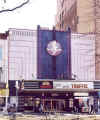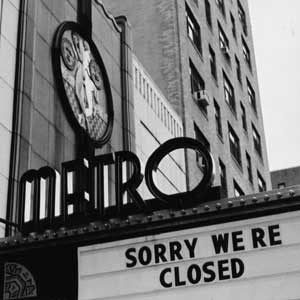 |
New York
Architecture Images-Upper West Side Metro Theater |
|
architect |
Boak & Paris |
|
location |
2626 Broadway, bet. W99 & W100. |
|
date |
1932-33 |
|
style |
Art Deco |
|
construction |
Terracotta facade |
|
type |
Theater |
|
|
 |
|
images |
  |
| Opening as the Midtown Theater, this
classic theater, located almost 60 blocks north of Times Square, survived
several tumultuous years. Beginning as a first run theater, the Midtown, now known as the Metro (Twin), switched to second run and then adult films during New York City's darker years (the 70's and 80's). Restored by Clearview Cinemas and twinned, the Metro has retained its beautiful and unique Art Deco facade. This underrated theater closed in January 2003, shortly after the Olympia met the reaper, but reopened only a couple months later. The Metro was once more closed by Clearview in August 2004.
Contributed by Cinema Treasures
The first features booked into the Metro when it reopened under the management of Cineplex Odeon in the summer of 1986 were 'She's Gotta Have It' and 'A Great Wall'. It operated as a first-run house until January of 2003 when the landlord suddenly shut its doors as the result of a lease dispute with Clearview Cinemas, which had assumed control of the Metro (and several other Manhattan theatres) in the fall of 1998 when Cineplex Odeon was forced to divest itself of a handful of sites around the country in anticipation of its merger with Loews Theatres. Suddenly, in April of '03, the Metro - still a Clearview property - opened for business again (showing 'Chicago' and the Chris Rock comedy 'Head of State' on its two screens); however, rumors still abound of its eventual closing, to be possibly replaced by yet another UWS high-rise apartment tower. Sadly, as of tonight, the marquee now reads "Sorry We're Closed," although as of last weekend it was still open. The low-rise building to its north is empty and I've heard they're going to be razed, so things don't look good for the Metro. I won't miss the uncomfortable seats, but I will miss its mere existence as the only movie theater betw. 84th St. and the Magic Johnson on 125th. If anyone knows anything about the future of the building I'd love to know. Maybe at least the facade will be preserved! The Midtown, designed by the architecture firm of
Boak & Paris, opened in 1933. From 1948 through April 1972, it was part
of the Brandt circuit, featuring sub-run foreign and independent fare
starting in the 1950s. It exhibited films such as Belle de Jour, Shame
(and just about every other Bergman movie), Breathless, Hiroshima Mon
Amour, Repulsion, L’Avventura, Straw Dogs, and Gimme Shelter, though
never in exclusive engagements. After Brandt's management, it operated
as an adult film venue. |
|
|
notes |
THE METRO TAKES A BOW The
marquee of the Metro Twin Theater at 99th and Broadway reads "SORRY Built in 1932-33 as the incongruously named Midtown, the Metro is admired for its striking Art Deco terra-cotta facade (complete with black "fins" at the top). The distinctive background of salmon and black sets off the building's most unusual feature: a large, circular emblem depicting comedy and tragedy masks alongside two human figures. With its innovative color and design, the theater commands attention from blocks away—especially at night when the neon marquee is blazing. There's nothing else quite like it in Manhattan. Cinemas often take on the personal histories of their communities, as evidenced by one sign-writer's comment: "The movie theatre that I lost my virginity in!" Public concern for the Metro is understandable in a neighborhood that has seen its once-numerous picture houses—among them the New Yorker, the Loew's 83rd Street and the Riviera—gradually replaced by condos and chain stores. A New York Times article last year hinted at the uncertainty of the Metro's future, while a contributor to Cinema Treasures (a website devoted to classic theaters) recently gave it up as "doomed for redevelopment." But in fact, everyone can all relax. Although no marker exists on the site, the Metro has been a designated New York City landmark for years—a fact confirmed with the help of the Landmarks Commission and Penny Ryan at Manhattan Community Board 7. "Gristedes has no connection with the property," insists Albert Bialek, general partner for the theater's owner, Broadway Metro Associates. "I don't know what made anybody think that." Instead of demolishing the building, Bialek plans to reopen it as "the ultimate art theater in New York." He recently bought out the existing lease with Clearview Cinemas, and will upgrade with new seats, carpeting and wider screens. A soon-to-be-named "celebrity operator" has been hired to run the theater and scout out cutting-edge films from around the world. If all goes according to plan, the new Metro could be unveiled as early as November. "We're changing with the neighborhood," Bialek says. "The Upper West Side is a place where a great art theater will be appreciated." For once, a New York theater story with a happy ending. |
|
links |